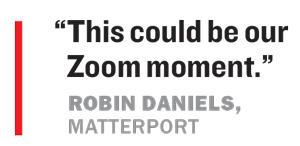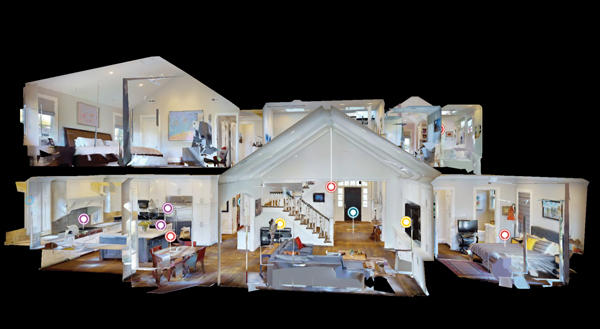Trending
Gearing up for a virtual world tour
For tech companies that host remote showings, the pandemic has provided a jolt that could shake up the space

Last August, R.J. Pittman hopped on stage at a Las Vegas conference to promote his company. A seasoned tech executive with stints at Apple, Google and eBay, Pittman was less than a year into his role as CEO of Matterport, which develops and sells cameras and software to create 3D digital models of interior space.
“Are you ready to step into the future?” he asked the audience packed with real estate executives and agents as he paced the stage in classic Silicon Valley fashion — dark jeans, sneakers and a blazer.
In hindsight, the more apt question was whether Matterport, and its smaller competitors, were ready for a baptism by fire. Within months, Covid-19 had turned Pittman’s far-reaching prediction that every property would have a “digital twin” in the “not-too-distant future” into an industry-wide expectation.
The market for creating 3D digital models across all property types is expected to explode from roughly $4 billion to almost $36 billion by 2025, a January report by the research firm MarketsandMarkets projected.
As coronavirus infections spread across the U.S. in March, halting property tours and face-to-face business dealings, the real estate industry seized up. In response, owners and real estate agents with property to lease or sell were forced to buy into Pittman’s vision of creating a digital way to tour space.
Some eagerly forked out thousands of dollars to set up the necessary equipment while others prepared with trepidation to give virtual tours.
“For years I think we all laughed at them,” said David Falk, president of the tri-state region at commercial brokerage Newmark Knight Frank, during a May webinar. But as the pandemic turned the real estate industry on its head, virtual tours quickly became vital — and companies enabling them reaped the rewards.
Now, larger players such as online listings giant Zillow Group and commercial real estate software company VTS are looking to get in on the action.
But Matterport remains a dominant force in the business. The Sunnyvale, California-based company, founded by Dave Gausebeck and Matt Bell in 2011, claims to have scanned 8 billion square feet of space and was valued at about $325 million last year on the heels of a $48 million funding round.
The company, which employs about 200 people, has a partnership with Google that allows its virtual tours to become searchable in Google Street View. It has the modest goal of becoming the Google Street View of interior space worldwide, and Covid has advanced that mission.
“It sounds horrible to say, in some ways, but it’s actually been really good for us,” said Robin Daniels, Matterport’s chief marketing. He joined the company in March, after stepping down from the same position at WeWork last fall.
“Everyone wants to put everything online,” Daniels said, “whether that’s your home, business, restaurant, you name it.”
A question of inertia
Not everyone in the real estate industry was caught off guard by the sudden preeminence of virtual tours.
The use of panoramic 360-degree photography and 3D digital modeling to sell and lease real estate has been around for a decade. But capturing these images can be costly and time-consuming.
 Blackstone Group was trying to bake virtual tours into its leasing efforts at Stuyvesant Town–Peter Cooper Village after purchasing the complex for $5.3 billion in 2015, according to a source familiar with the matter.
Blackstone Group was trying to bake virtual tours into its leasing efforts at Stuyvesant Town–Peter Cooper Village after purchasing the complex for $5.3 billion in 2015, according to a source familiar with the matter.
Blackstone subsidiary Beam Living, the property’s manager, sought to introduce virtual tours through a startup called GeoCV, which would capture a digital twin of the space using 3D photography. Beam Living has since switched to Matterport.
The East Side complex has relatively high occupancy, which can make touring a logistical land mine. And because the units have fairly standardized layouts, the thinking was that prospective tenants could virtually tour apartments shot while they were vacant. But Blackstone’s effort, meant to streamline leasing for the 11,000-plus apartments, never quite caught on prior to Covid.
That one of the world’s largest commercial landlords did not accelerate virtual tours at Stuy Town is testament to the question providers and proptech companies have heard again and again: Why fix what isn’t broken?
“It’s the whole innovator’s dilemma,” the source said. “Even though Blackstone is very much forward-looking, you have the traditional way of doing things that have inertia.”
Representatives for Blackstone and Beam Living declined to comment.
Others say there’s a reason it took a black swan event like the pandemic to prompt the adoption of virtual tours.
Julia Spillman, a broker with Douglas Elliman and CEO of its star Eklund-Gomes team, has surveyed many of the companies selling cameras and software platforms for virtual tours and been “disappointed.”
Spillman said the image quality in most of the offerings would suffice for a house in a smaller market but be grossly inappropriate for a multimillion-dollar property in New York City, Miami or Los Angeles, where the Eklund-Gomes team handles luxury listings.
Even Matterport, which is widely viewed as the leader in 3D virtual tours, didn’t fully pass Spillman’s smell test. She described the 3D models of properties scanned by Matterport and other companies as “scary spinning doll houses.”
“I’m still confused where that’s ever going to get anyone,” Spillman said, though she noted that the experience was better when agents gave guided tours through Matterport’s 3D scans.
VTS CEO Nick Romito echoed her concerns and said that VTS’ defacto virtual tour offerings for commercial owners is a standard video that’s shot and edited by the firm’s in-house team.

Matterport is pushing to bring 3D digital models of properties to consumers’ iPhones
“Trying to video game your way through a space isn’t the best experience,” Romito, who said he’s a “big fan” of Matterport, noted. “But I think from a marketing perspective, most people’s preference is to hit play.”
But he, Spillman and other real estate players agree that the pandemic is profoundly changing things. Many say the prevalence of remote showings will be one of the lasting impacts.
Zooming in
Some property owners, agents and brokerages have vowed to never again list a property without preparing the digital assets for a virtual tour.
Those assets are largely determined by an agent’s budget. Some opt for professional videos; others film a walk-through using their phone. Many shell out thousands for pricey cameras that, when paired with Matterport’s software, can create a 3D version of the home where measurements can be taken virtually.
Just as photographs became the bare minimum for listing a property, a virtual tour seems poised to become a prerequisite. The question is whether the companies providing the camera kits, software and web hosting for remote showings will be able to keep up with demand.
Some of the most popular specialty cameras have been perpetually out of stock or on weeks-long back order since March, said Dan Smigrod, who runs We Get Around Network, a global forum about 3D and 360-degree photography with over 6,500 members.
“Even if you want to start creating 3D or 360 virtual tours for your properties … you may be challenged even finding a camera,” he said. Smigrod added that a survey found photographers have doubled their bookings and that his forum’s traffic has tripled.
Fremont, California-based Asteroom, a company that stitches together 360-degree photographs to create virtual tours, was striking up new partnerships and selling 100 camera kits and subscriptions a day before running out of stock in mid-April, for example.
Even Matterport scrambled. The pandemic hit as the company was pivoting away from selling cameras and to software that works with any device. So Daniels set out to see if he could speed the debut of the company’s iPhone app, which was originally slated for the end of this year. In early May, Matterport released a public beta version.
At the same time time, the company was dealing with other concerns. In mid-April it cut 90 jobs — a third of its workforce. A month later it closed on $40 million in equity funding without the typical fanfare of a fundraiser. Matterport declined to identify the investors involved or comment on the layoffs.
Daniels said the latest cash infusion will drive rapid expansion and serve as the company’s rainy day fund. “We’re trying to be really cash conservative but at the same time not miss this opportunity,” he said. “This could be our Zoom moment.”
Other big companies see similar opportunities.
In late March, Zillow launched a free platform that builds 3D tours using panoramic photos taken on a phone camera or compatible 360-degree cameras.
And in late June, VTS launched its new office listings platform, touting that its offerings include virtual tours. Since mid-March, the proptech unicorn says its added 60 million square feet worth of properties in New York City, bringing the square footage on its platform in the city to nearly 350 million.
Romito denied the launch or marketplace features were influenced by the pandemic. He said providing virtual was the premise of VTS, which he founded in 2012, and pointed to the firm’s formal name, View the Space.
“Because our software product got so big so fast, a lot of people forgot that we enteredthe market this way,” Romito said. “We were the first ones to do virtual tours in the space.”
Romito added that VTS’ virtual tour offerings does not include 3D or 360-degree photography; most of VTS’ virtual tours are standard video shot and edited by an in-house team. That said, VTS displays and shoots 3D tours with Matterport for its clients on request.
He said VTS may consider producing digital twins in the long term but that “would probably be an acquisition for us versus a build.”
Muscling through
In the early aughts, taking 3D or 360-degree photos was akin to joining a priesthood, according to Smigrod, the photographer and WGAN forum founder. The prerequisite of understanding both photography and software took up huge swaths of time, he recalled.
That changed in 2014 for Smigrod when Matterport first brought its software, hosting and distribution platforms to market.
“It was a little bit like inventing the light bulb and electricity at the same time,” Smigrod said. “I mean, it was that dramatic.”
Today Smigrod counts close to 160 companies offering platforms to create, host and distribute 3D and 360-degree tours. And while a growing number of companies are trying to capitalize on virtual tours, Matterport is widely considered the firm to beat in 2020.
Asteroom is one of the handful of newer startups in the space. Founded by Eric Tsai in 2018, the company has raised $1.5 million and its business plan, like that of many others, is focused on undercutting Matterport on cost and speed.
Asteroom charges as little as $20 per month, and $60 for up to 10 users. Matterport’s new app costs $10 per month, a professional subscription about $70 and a business subscription for 20 users $310. Before Matterport launched its app, customers had to use a special camera.
Tsai noted that putting together a 360 tour with Asteroom is less time-intensive than with a Matterport model. Asteroom requires one photo per room, while Matterport requires scans every six feet for its software to produce a 3D model of the space.
“I believe virtual tours are supposed to be inexpensive and easy,” Tsai said. Though he admitted Matterport’s scanning and software produce a higher image quality, he argued that it is often lost on consumers.
“The end product is mostly the same,” he said. “Most people can’t tell.”
Daniels argued otherwise and said Matterport’s 3D models allow for functions, such as measuring, that a 360 tour does not. He called his new app a solution that will save time and money. He also professed to be unconcerned by the competition and said the market is big enough for multiple players, noting that part of Matterport’s pivot to software development assumes other companies will build hardware that complements its 3D modeling.
“It’s not going to be a thing where one company dominates anytime soon,” Daniels said.
But some of the company’s smaller competitors may see it differently. Matterport, for example, sued New York-based GeoCV, its closest U.S. competitor, over alleged patent infringement two years ago and effectively wiped it out.
“Basically GeoCV was … a much, much smaller company than Matterport, and it just didn’t have a financial ability to defend itself and to prove its innocence,” Anton Yakubenko, the firm’s co-founder and CEO, told TRD.
He had founded GeoCV in 2014 with the goal of producing affordable 3D home tours through a smartphone app. But after the lawsuit, Yakubenko said his investors, who had poured $3.3 million into the startup, were looking for an out.
In October 2019, GeoCV announced it was winding down operations with the majority of its engineering staff, including Yakubenko, and launching an office under the Silicon Valley-based 3D imaging firm Occipital. Though GeoCV continues servicing existing clients — and has seen an uptick in requests for tours during the pandemic — the company is not taking on new business.
The suit with Matterport is set to go to trial next year.
“The lawsuit has accelerated, let’s say, the desire of shareholders to exit from the business,” Yakubenko said.
Matterport declined to comment on the dispute.
The elephant in the room?
Dave Eisenberg was one of Matterport’s first investors, through his seed stage venture capital firm, Red Swan.
The tech investor met Matterport’s founders at a Mountain View meetup in 2011 and was instantly sold. “I said, ‘I’m totally convinced that this is the future,’ and I wrote a check,” he said.
Eisenberg said that he wasn’t privy to the case against GeoCV but noted that it’s the way the game is played in Silicon Valley.
“You see this happen from time to time, whether it’s Microsoft or Oracle or Google,” he said. “Matterport, because they were early and because they were sophisticated and filed a number of patents in the early years … they were effectively protecting their turf.”
Eisenberg added that he doesn’t expect another company to rival Matterport because the virtual tour market’s dynamic doesn’t appeal to venture capitalists. “The market is just not big enough,” he said. “I don’t even understand what the thesis could be for someone to want to fund a challenger.”
Yakubenko echoed the sentiment, explaining that the software used to turn photos into 3D models is based on machine learning that takes time to develop. Matterport, and GeoCV until 2018, had a few years’ head start over many competitors.
There are still challengers, however, and some have been working in the space for just as long.
NavVis, a German company that’s raised nearly $70 million, has its sights on the U.S. market and global expansion. Founded in 2013, NavVis focuses on commercial real estate, largely targeting engineering and construction firms. But it has made in-roads providing digital twin models to brokers at JLL and CBRE.
“There’s a lot of players in the space, and they all offer a different flavor,” Smigrod said. “Is there room for all these players today? Yes. Will we see at some point some consolidation? Sure, probably.”
What’s certain, Smigrod noted, is that Covid has hastened the adoption of virtual tour technology, irrespective of form. “The last four months might have taken four to five years without the pandemic,” he said.
That could push Matterport to Wall Street for funding. Daniels said that while an IPO isn’t happening “anytime soon,” going public is part of the endgame.
“You join a company like this because you think about the opportunity of how big it could be,” he said. “I got close to a public offering with WeWork, and it didn’t quite happen, so I’d like this one to happen.”




